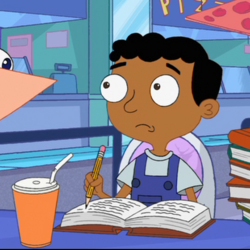The portrayal of South Asians in western cinema: the good and the bad

Baljeet, the token Indian character from the popular children’s animated series “Phineas and Ferb” pictured profusely studying.
December 19, 2021
Since the release of the globally successful “Squid Game,” the representation of Asians in western media has changed dramatically. In some ways, it is beneficial, since more people are becoming aware of the Asian significance in society. “Squid Game” is also not the only Asian-based form of popular entertainment, since others have different ways of portraying Asians. The question is, which ones are respectful, and which ones are derogatory?
Hollywood and American television is infamous for its long trail of stereotypical Asian tropes, and often its mainstream childhood shows and movies that have helped to perpetuate these derogatory stereotypes of Asians. The iconic “Phineas and Ferb”, for example, portrayed the Indian character Baljeet as having a thick accent, studying—particularly math—profusely (even on summer vacation) and refraining from standing up for himself despite being bullied by another character throughout the entirety of the show. His character served really no other purpose than to bring in comedic relief, which was spurred by the fact that his habits differed so greatly from the habits of the show’s American viewers. “Jessie” and “Bunk’d” are other prominent examples of shows that have butchered Asian representation in big screen television, further contributing to the derogatory Asian stereotype. The character Ravi Ross in both shows is adopted from India, has a thick accent, and is the smartest person of the group, following the stereotype of Indians being extremely book-smart and retaining their ethnic accent.
By using these characters as punchlines, it is emphasized that Asians strikingly differ from Americans in ‘funny’ ways, and being South-Asian Americans ourselves, our conception of our culture undoubtedly has been negatively influenced by shows like these.
On the other hand, there are some shows that represent Asians very well. The Netflix series “Never Have I Ever” is a prime example of a harmless and positive depiction of an Asian lead character: Devi Vishvakumar. She is shown to be a typical American teen, and even though she has Indian origins, the show does not use that to make her stereotypical or different from anyone else. She goes to parties, gets drunk and has a boyfriend, just like all her other classmates. The show also has a Chinese-American and a Japanese-American character, and in no way are they shown to be different because of their race. The show also shows characters of other minorities besides Asians, such as Jews and members of the LGBTQ+ community, and they are also shown as being equal to their classmates.
Conversely, this better representation of Asians in Western media has positively led us to embrace our culture more rather than shun it away. By scrapping the stereotypical depiction of Asians as grade-obsessed and thick-accented, the creators of “Never Have I Ever” have made us feel visible and not simply caricatured as being strikingly different from our white counterparts. We see that our heritage does not simply amount to us being ridiculed on mainstream television and can actually add heavy value to who we are as people.
With shows and movies from abroad such as the globally acclaimed Netflix series “Squid Game” garnering more and more attention, it is important to recognize that not every Asian can be said to be like a character from “Squid Game” as that is simply perpetuating the stereotype of Asians being seen as “foreign” in American eyes and constraining the extent of their representation in media. Contrary to popular belief, “Squid Game” and other Korean dramas are not the only shows with Asian characters, and being Asian does not automatically amount to being similar to any of the characters depicted on these television shows and movies. This can be taken into account in the production of future Western television shows and movies, and it can be used to alter the preconception of Asians many Americans have subconsciously formed in their minds.
While the depiction of Asians in Western cinema has significantly improved and increased from years past, it is still not at an ideal level. This not only hampers our perception of ourselves as well as our culture but also will both directly and indirectly impact those of generations to come.

